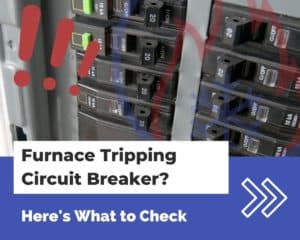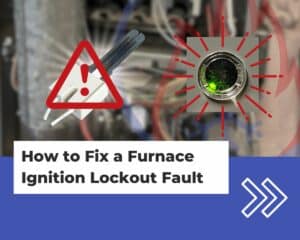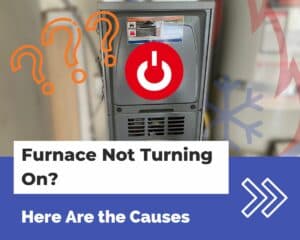If you’re looking at getting a new furnace for your home, you might be confused with all the terminology. Especially the difference between upflow vs downflow furnaces.
How are upflow and downflow furnaces different? Does it even matter?
The truth is that while upflow and downflow furnaces differ in their airflow direction, your choice of getting one versus another isn’t a matter of which is better, rather, it is more dependent on the design of your home and its HVAC system.
In this article, I’ll delve deep into the operational mechanisms of upflow and downflow furnaces, explore their efficiency, shed light on installation nuances, and even touch upon serviceability aspects.
Additionally, I’ll debunk some common misconceptions and provide guidance for those looking to replace or choose a furnace system for their home.
The Differences Between Upflow and Downflow Furnaces
The main difference between an upflow and downflow furnace is their airflow direction:
An upflow furnace pulls in its return air from the bottom and blows its supply air out through the top, while a downflow furnace takes in its return air from the top and blows its supply air out of the bottom.
Here’s another way to tell the difference between an upflow and downflow furnace:
- An upflow furnace has its blower mounted below the heat exchanger
- A downflow furnace has its blower mounted above the heat exchanger


However, there are also a few other differences between upflow and downflow furnaces:
- Heat exchanger positioning and design
- Efficiency considerations
- Installation and ductwork configurations
- Serviceability and maintenance
I’ll go over these differences below.
Heat Exchanger Positioning and Design
- In an upflow furnace, the heat exchanger is designed to allow for efficient transfer of heat to the incoming air from below. Since hot air naturally rises due to its lower density, this provides a very slight efficiency advantage to upflow furnaces.
- In a downflow furnace, the heat exchanger has to transfer heat to air that’s being forced downward. This means that there is a slight efficiency loss due to the inclination of heated air to rise, not fall.
Efficiency Considerations
While it’s true that warm air rises and cool air sinks, both upflow and downflow furnaces can be designed to be highly efficient.
However, the natural dynamics of hot air movement can make upflow systems slightly more efficient in multi-level buildings where the natural movement of rising warm air can be taken advantage of.
However, the natural movement of hot air should only be taken into account in taller multi-story buildings with larger HVAC systems. It doesn’t matter for most homeowners.
So are downflow furnaces efficient? Yes, downflow furnaces can be just as efficient as upflow furnaces.
One study found that the efficiency ratings of downflow furnaces are often similar to that of their upflow counterparts.
Here’s what’s important: The efficiency of a furnace system is largely determined by its design, components, and installation, NOT its airflow orientation.
Installation and Ductwork Configurations
- Upflow furnaces are usually installed in garages or basements. The garage or basement provides a space for the furnace to reside and gives a clear pathway for the furnace’s supply air to be distributed upward into the home.
- Downflow furnaces are common for homes that have ductwork run underneath them in a crawl space. In this scenario, the furnace could be located inside the home in a utility closet while the ductwork runs through the crawl space.
Serviceability and Maintenance
The configuration and placement of the furnace’s components are different in an upflow versus downflow furnace.
The accessibility of the furnace’s components might make it more practical to install one type of unit versus another.
For example, it might not be practical to install an upflow furnace in a tight area where access to the furnace’s internal components might be inhibited.
Or it may be more practical to install a downflow furnace in a space where its condensate drain line is accessible for cleaning.
These are just examples, every home is different, and there are an infinite amount of factors that come into play when deciding to install one type of furnace versus another.
Upflow vs Downflow Furnace – Which Is Better?
The question of whether an upflow or downflow furnace is “better” is not one-size-fits-all.
The best furnace choice depends on specific circumstances such as the architecture of the home, the current ductwork, climate, and serviceability.
Let’s look at the advantages and considerations of both types of furnaces:
Upflow Furnace Advantages
- Natural Convection: Warm air naturally rises, and upflow furnaces take advantage of that. By having warm air flow upwards, upflow furnaces are generally slightly more efficient.
- Basement Heat Retention: If an upflow furnace is installed in a basement, any radiant heat loss from the furnace can warm up a cold basement.
- Condensate Management: If you have a high-efficiency upflow furnace, its condensate drain will stem from the top of the unit, allowing for more gravity-assisted drainage options.
Downflow Furnace Advantages
- Attic Installations: A downflow furnace is the logical choice for installation into an attic, which most homes have.
- Ductwork Integration: In scenarios where the home’s duct system is integrated into the floor or the crawl space, a downflow furnace can connect seamlessly to this configuration without the need for extensive duct modifications.
- Even Heat: If your downflow furnace uses floor vents to distribute air, warm air will be distributed more evenly throughout your home, since hot air tends to rise.
Upflow vs Downflow Furnace – Which Should You Choose?
If you’re replacing a furnace for your home, the most critical factor to take into account is whether the old furnace was an upflow or a downflow. You’ll want to install the same type of furnace as the old one.
Some HVAC companies try to upsell homeowners on a complete new system. They will often say that their old downflow system is inefficient and that they should completely rip out the old system, ductwork and everything, and replace it with an upflow system.
The truth is that while yes, upflow furnaces are, generally speaking, slightly more efficient, the energy savings gained from completely overhauling your HVAC system to install a new upflow furnace is minuscule, and you’ll never recoup the costs of installation by the supposed energy savings you’ll receive.
In actuality, there are tons of other factors that affect the efficiency of your furnace much more than whether it’s an upflow or downflow system, such as the air vent placement, the insulation in your home, and whether it’s a high-efficiency furnace.
If you’re getting your furnace replaced, a legitimate HVAC company will take note of the type of furnace that you’re replacing, whether it’s an upflow or downflow, and recommend furnaces that are the same type. So they should replace an upflow with an upflow or a downflow with a downflow.
Only in rare circumstances should an HVAC company recommend replacing a downflow with an upflow, such as if your home is undergoing a complete renovation, and the furnace needs to be relocated anyway.
Upflow Horizontal and Downflow Horizontal Furnaces
As if there wasn’t enough confusion about the differences between upflow and downflow furnaces, there are also upflow horizontal and downflow horizontal furnaces.
While this seems like another layer of complication, it’s quite simple:
- An upflow horizontal furnace is an upflow furnace that can also be installed in a horizontal configuration.
- A downflow horizontal furnace is a downflow furnace that can also be installed in a horizontal configuration.



